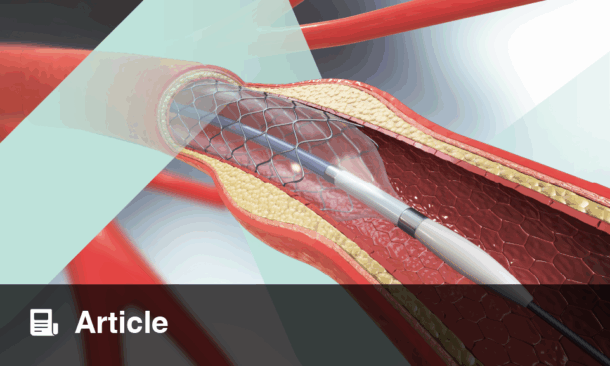BACKGROUND
The optimal form of treatment for left main (LM) coronary artery disease, a form of atherosclerosis, is still debated. The aim of this study was to assess the effectiveness and safety profile of the distal LM stenosis treatment with the new cobalt-chromium sirolimus-eluting BiOSS LIM® C stent (Bifurcation Optimization Stent System, Warsaw, Poland).1-3
METHODS
BiOSS LIM C is a coronary-dedicated bifurcation sirolimus-eluting balloon expandable stent made of cobalt-chromium (strut thickness: 70 µm). It is coated with a biodegradable polymer comprised of lactic and glycolic acids. The polymer releases sirolimus in a time-controlled manner lasting around 8 weeks. The stent consists of two parts with different diameters connected with two struts 1.7 mm in length. BiOSS LIM C is mounted on a dedicated bifurcation balloon, Bottle® (Balton, Warsaw, Poland). The stent delivery is a rapid exchange system.4-7 Between September 2016 and December 2017, patients from two Polish centres with a final diagnosis of stable coronary artery disease or acute coronary syndrome without ST-segment elevation who had signed informed consent documents were enrolled. Patients with ST-elevation myocardial infarction (MI) or Medina type 001 bifurcation lesions were excluded from the registry. Provisional T-stenting was the obligatory strategy. Double antiplatelet therapy is planned for 6–12 months. An angiographic control with intravascular ultrasound or optical coherence tomography (OCT) is planned at 12 months. The primary endpoint is the rate of cardiac death, MI, and target lesion revascularisation at 12 months. The authors have presented the interim results here.
RESULTS
The study so far included 53 patients with stable coronary artery disease or non-ST-elevation acute coronary syndrome (67.9% versus 32.1%, respectively). The mean age of enrolled patients (77.4% males) was 66.26±8.57 years. There were 47 (88.7%) patients with hypertension, 23 (43.4%) with diabetes, and 30 (56.6%) with prior MI. Additionally, 28 patients (52.8%) underwent prior percutaneous coronary intervention, while 11 (20.8%) patients had previous coronary artery bypass graft. The mean SYNTAX score was 22.52±7.58 and EuroScore II was 1.62%±1.70%. True bifurcations were treated in 70.1% of cases. According to the Medina classification, true bifurcations were present in 70.0% of cases. All BiOSS stents were implanted successfully (average pressure: 15 atm). The mean nominal stent parameters were as follows: 4.17±0.36 mm x 3.42±0.35 mm x 19.94±3.16 mm. In 15 (28.3%) cases, the second stent was implanted within the side branch with the use of the T and protrusion technique. The proximal optimisation technique was performed in 37 cases (69.8%), and in 92.5% this required radial access. In 3 cases (5.7%) periprocedural MI was diagnosed. At 1 (n=51) and 3 (n=47) months, all patients had not experienced any cardiac event (out-of-hospital major adverse cardiac event rate was 0%). At 12 months (half of the patients were controlled) in OCT analysis neointima burden was comparable between proximal and distal part of the stent and did not exceed 30%.
CONCLUSIONS
New dedicated bifurcation BiOSS LIM C stents seem feasible devices with promising effectiveness and safety in distal LM stenosis. Complete BiOSS LIM C angiographic and OCT data will answer the question as to whether the new stent platform with thin struts that was used is advantageous.








